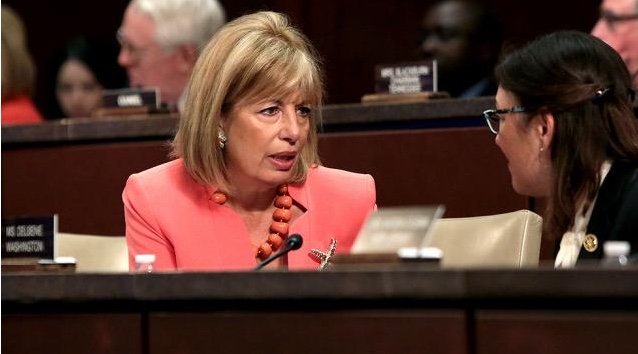Thirty-nine years after the deaths in Guyana, Peoples Temple and Jonestown continue to make the news on a regular basis.
 Following the June 14, 2017 shooting of U.S. Rep. Steve Scalise during a practice session before a congressional baseball game, U.S. Rep. Jackie Speier was interviewed about the shooting at the Port Kaituma airstrip near Jonestown in November 1978, which left her wounded and her boss, then-U.S. Rep. Leo Ryan, dead. “Having been shot five times was a horrific experience and it stays with you the rest of your life,” Speier said during an interview on television station CBSSacramento.
Following the June 14, 2017 shooting of U.S. Rep. Steve Scalise during a practice session before a congressional baseball game, U.S. Rep. Jackie Speier was interviewed about the shooting at the Port Kaituma airstrip near Jonestown in November 1978, which left her wounded and her boss, then-U.S. Rep. Leo Ryan, dead. “Having been shot five times was a horrific experience and it stays with you the rest of your life,” Speier said during an interview on television station CBSSacramento.
Rep. Speier made similar comments after the mass shooting in Las Vegas in early October 2017. Identified in one publication as “one of two current members of Congress to have survived being shot as part of a mass shooting” – the second being Rep. Scalise – Ms. Speier was described as “one of a growing list of Democrats calling for Congress to pass gun control legislation.” “No more moments of silence,” she tweeted the day after the incident, “the best way to honor the #LasVegasShooting victims is a moment of action to prevent further senseless deaths.”
Jonestown in commentary
“There’s a Jim Jones in Michigan”: Lawmaker Likens Flint Crisis to Cult Leader Who Poisoned Members
Democracy Now, 4 February 2016
During a congressional hearing on lead poisoning in the water supply of Flint, Michigan, a crisis which began after an unelected emergency manager appointed by Republican Governor Rick Snyder switched the source of Flint’s drinking water to the corrosive Flint River, Texas Congresswoman Sheila Jackson Lee compared the poisoning of the residents to Jonestown. “As I sit here today, the memories of a Jim Jones, who gave a poison concoction to children, causes me to say that there is a Jim Jones in Michigan who gave a poison concoction to children and their families. If any of us should demand accountability, we should.”
TRUMPTOWN: A swirling Jonestown Vortex of cult-like brainwashing and Trumpist madness
by Andrew W. Griffin, Red Dirt Report, March 7, 2017
While the author documents the similarities between Donald Trump and his supporters to other groups – the Branch Davidians, Heaven’s Gate, and Alex Jones, among others – he begins with “the notorious and crazed cult leader Jim Jones … [and] the Jonestown Massacre of November 1978 at the Peoples Temple in Guyana.”
Eight steps to mind control: How cults suck ordinary people in
by Charity Norman, news.com.au, May 26, 2017
Leading off with Peoples Temple as its prime example, the article offers the warning signs in recognizing groups that would use mind-control techniques to attract converts, including “Love-bombing, … renouncing loved ones … [and] zero tolerance of criticism.”
Black women were getting exploited by cults long before R Kelly
by Zak Cheney Rice, Mic Network, July 19, 2017
In an article commenting upon a report that “R&B superstar R. Kelly has been holding several young women captive in what their families describe as a ‘cult’,” the writer reminds his readers that most people associate the term “cult” with such events as Jonestown and the Manson murders, and suggest its use in this instance might be an exaggeration. The article goes on to point out, however, “black women and girls have been exploited by cults, new religious movements and cultic relationships with startling frequency. And these victims have, for the most part, stayed invisible to the public.”
Opinion: 76 trombones, the loyalties to con men
by D.G. Martin, columnist, Hickory (NC) Record, August 2, 2017
In a column identifying con men and describing their characteristics, D.G. Martin listed Adolph Hitler in Germany, U.S. Senator Joseph McCarthy, Huey Long in Louisiana, and Hugo Chavez in Venezuela, Fidel Castro, and Jim and Tammy Bakker. “The stories of such con men are legion. Oftentimes, they are godlike figures to their followers. Jim Jones’s powerful charismatic ministry drew a community of people to his People’s Temple commune in Jamestown, Guyana, South America. They followed Jones’s orders loyally and without question. On November 18, 1978, when trouble came, 909 inhabitants of Jonestown died in a mass suicide directed by Jones. They drank a Kool-Aid-like punch dosed with cyanide poisoning, following their leader to the death.… You see my point, don’t you? One question: Have I overlooked anybody?”
N. Korea’s cult needs an enemy
by Dave Nagle, guest columnist, Waterloo Cedar Falls (IA) Courier, October 2, 2017
The author compares the current regime in North Korea to the community of Jonestown when he notes: “While [Jonestown] is but one illustration of the power of a cult following, it has remarkable relevance when we try to understand the Democratic People’s Republic of Korea.” Less important than the characteristics of Kim Jung Un, though, is how the United States responds to its adversary. “We must recognize we are dealing with a cult, admittedly government sponsored, but a cult nonetheless. Its foundation is based on hostility toward America. We should not continue to act as his direct adversary,” the column concludes. “Cults do not respond rationally to perceived dangers. Jonestown should have taught this lesson. A cult needs a visible, viable enemy. Donald Trump should not provide North Korea with one.”
Jonestown and Heaven’s Gate were supposed to be utopias. How did it go so wrong?
by Amos Barshad, Fader, Fall 2017
Using The Road to Jonestown by Jeff Guinn as a point of departure, this commentary looks at the utopian vision of two groups – Peoples Temple and Heaven’s Gate – which self-destructed in the late 20th century. “Dystopia and utopia are antonyms, or at least they’re supposed to be. One is an absolute nightmare, the other a perfect dream. In practice, like in Jonestown, the two extremes can thread together. In any given aspiring utopia — in its grand gambles, in its bold social experimentation — there is the seed for unspeakable calamity. Just like that, the dream can become the nightmare.”
Drinking the Kool-Aid
 The expression “drinking the Kool-Aid” is now deeply embedded into American slang, often as throwaway and/or commonly-understood lines in politics, sports, business, and popular culture – this website noted more than 400 examples within the last years, most often used by writers and speakers who likely did not know the origin of the phrase – but there were a few times in which the usage was discussed. They include:
The expression “drinking the Kool-Aid” is now deeply embedded into American slang, often as throwaway and/or commonly-understood lines in politics, sports, business, and popular culture – this website noted more than 400 examples within the last years, most often used by writers and speakers who likely did not know the origin of the phrase – but there were a few times in which the usage was discussed. They include:
drinking the kool aid
Urban Dictionary, February 26, 2017
The Urban Dictionary, which tracks use of new jargon, idioms and slang, regularly updates its entries as words and phrases evolve. While the entry of February 26, 2017 tries to marry the events at Jonestown with the “radicalism of the 60s counterculture” captured by the book, The Electric Kool-Aid Acid Test by Tom Wolfe, the commentary continues with a more nuanced and sympathetic interpretation of the phrase, including the observation that: “Drinking the Kool-Aid doesn’t mean that friendships are bad, but that people who drink the Kool-Aid lacked discernment in who they got involved or connected with.”
Using Jargon Not Always a Crime
by Tricia Warren, “Guerrilla Sales & Marketing,” Memphis Daily News, August 2, 2017
Jargon is so widespread in business that it has become its own language. If you’ve ever asked others to “buy into” an idea, “think outside the box,” or “drink the Kool-Aid,” you’re “guilty” of jargon. While you’ve probably heard avoiding jargon is a best practice, using jargon isn’t always a crime.
Peoples Temple in History
As the 40th anniversary of the deaths in Jonestown approaches, the Temple appeared in numerous articles offering historical references or context. Among them:
Jonestown Massacre takes the lives of hundreds in a mass suicide-murder in 1978
New York Daily News, November 17, 2016
This Daily News Flashback reprints the paper’s original article from Nobvember 20, 197
Chronicle Covers: Jonestown massacre’s gut-wrenching aftermath
by Tim O’Rourke, San Francisco Chronicle, November 21, 2016
This story presents the Chronicle’s front page from Tuesday, November 21, 1978, which devoted its entire coverage to the tragedy, including a subhead – “Hundreds Fled into the Jungle” – which was one of many to give rise to false rumors and conspiracy theories which persist to the present.
Under the spell of Jim Jones: Inside the tragedy of the Jonestown massacre
by Eun Kyung Kim, Today Show, April 4, 2017
The first day of a week-long series on The Today Show included conversation with Jeff Guinn, the author of the then-just-published book, The Road to Jonestown, as well as Jonestown survivors Jim Jones Jr. and Leslie Wagner-Wilson.
The coverage also included a sidebar, “Hear the eerie connection between the Patty Hearst saga and the Jonestown tragedy,” describing how Temple leader Jim Jones offered himself in a prisoner exchange for the newspaper heiress with Hearst’s captors, the Symbionese Liberation Army.
Editorial: A watershed moment in city’s housing wars
Editorial, San Francisco Chronicle, August 4, 2017
Guyana News
Guyana Strikes Oil: What the Windfall Means for the Country—and the Region
by Raul Gallegos, Foreign Affairs, February 2, 2017
As its point of departure, the article evokes the images of Jonestown, where “Reverend Jim Jones convinced nearly 1,000 of his followers to hole up in their socialist commune and commit mass suicide by drinking cyanide-laced Kool-Aid.” As an even greater threat to its self-destruction, the article continues, Guyana has just discovered a massive amount of oil off its territorial waters.
Suicide capital of the world
by Mark Hodge, The Sun, London, England, March 8, 2017
In an article analyzing Guyana’s suicide rate – the highest in the world – the author evokes the image of the deaths in Jonestown numerous times, with such observations as: “The most common method [of suicide in Guyana] – like Jonestown – is poison, generally involving pesticides or rat poison.”